The Scales F Lightweight
Page 50
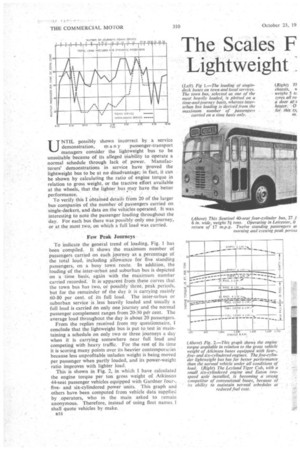
Page 51
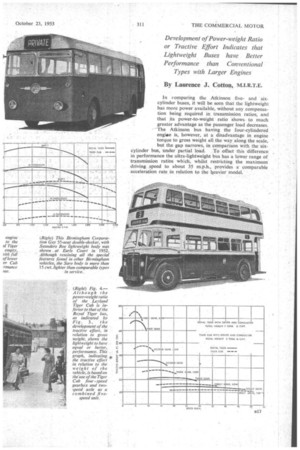
Page 52
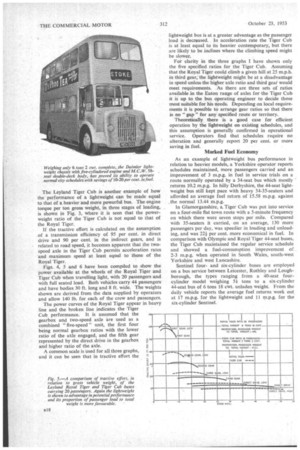
Page 55
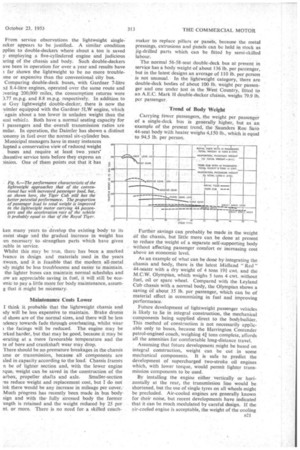
Page 56
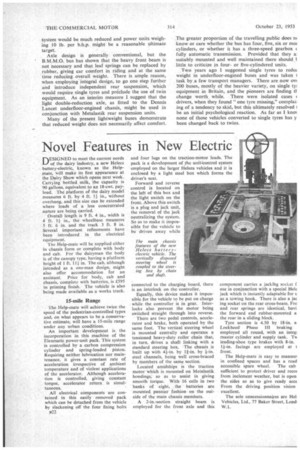
If you've noticed an error in this article please click here to report it so we can fix it.
By Laurence J. Cotton, M.I.R.T.E.
UNTIL possibly shown incorrect by a service demonstration, many passenger-transport managers consider the lightweight bus to be unsuitable because of its alleged inability to operate a normal schedule through lack of power. Manufacturers' demonstrations in service have proved the lightweight bus to be at no disadvantage; in fact, it can be shown by calculating the ratio of engine torque in relation to gross weight, or the tractive effort available
at the wheels, that the lighter bus may have the better ,
performance.
To verify this I obtained details from 20 of the larger bus companies of the number of passengers carried on single-deckers, and data on the vehicles operated. It was interesting to note the passenger loading throughout the day. For each bus there was possibly only one journey, or at the most two, on which a full load was carried.
Few Peak Journeys To indicate the general trend of loading, Fig. 1 has been compiled. It shows the maximum number of passengers carried on each journey as a, percentage of the total load, including allowance for five standing passengers, on a busy town route. In addition, the loading of the inter-urban and suburban bus is depicted on 4 time basis, again with the maximum number carried recorded. It is apparent from these curves that the town bus has two, or possibly three, peak periods, but for the remainder of the day it is carrying mainly 60-80 per cent, of its full load. The inter-urban or suburban service is less heavily loaded and usually a full load is carried On only one journey and the normal passenger complement ranges from 20-30 per cent. The average load throughout the day is about 20 passengers.
From the replies received from my questionnaire, I conclude that the lightweight bus is put•to test in maintaining a schedule on only two or three journeys a day when it is carrying somewhere near full load and competing with heavy traffic. For the rest of its time it is scoring many points over its heavier contemporaries because less unprofitable unladen weight is being moved per passenger when partly loaded, and its power-weight ratio improves with lighter load.
This is shown in Fig. 2, in which I have calculated the engine torque per ton gross weight of Atkinson 44-seat passenger vehicles equipped with Gardner four-, fiveand six-cylindered power units. This graph and others have been computed from vehicle data Supplied by operators, who in the main asked to remain anonymous. Therefore, instead of using fleet names. 1 shall quote vehicles by make.
B! 6 In comparing the Atkinson fiveand six. cylinder buses, it will be seen that the lightweight has more power available, without any compensation being required in transmission ratios, and that jts power-to-weight ratio shows to much greater advantage as the passenger load decreases. The Atkinson bus having the four-cylindered engioe is, however, at a disadvantage in engine torque to gross weight all the way along the scale, but the gap narrows, in comparison with the six cylinder bus, under partial load. To offset this difference in performance the ultra-lightweight bus has a lower range of transmission ratios which, whilst restricting the maximum driving speed to about 35 m.p.h., provides a: comparable acceleration rate in relation to the tieavier model.
The Leyland Tiger Cub is another example of how the performance of a lightweight can be made equal to that of a heavier and more powerful bus. The engine torque per ton gross weight, in three stages of loading, is shown in Fig. 3, where it is seen that the powerweight ratio of the Tiger Cub is not equal to that of the Royal Tiger.
If the tractive effort is calculated on the assumption of a transmission efficiency of 95 per cent. in direct drive and 90 per cent. in the indirect gears, and is related to road speed, it becomes apparent that the twospeed axle in the Tiger Cub permits acceleration rates and maximum speed at least equal to those of the Royal Tiger.
Figs. 4, 5 and 6 have been compiled to show the power available at the wheels of the Royal Tiger and Tiger Cub when travelling light, with 20 passengers and with full seated load. Both vehicles carry 44 passengers and have bodies 30 ft. long and 8 ft. wide. The weights shown are derived from the data supplied by operators and allow 140 lb. for each of the crew and passengers.
The power curves of the Royal Tiger appear in heavy line and the broken line indicates the Tiger Cub performance. It is assumed that the gearbox and two-speed axle are used as a combined " five-speed " unit, the first four being normal gearbox ratios with the lower ratio of the axle engaged, and the fifth gear represented by the direct drive in the gearbox and higher ratio of the axle.
A common scale is used for all three graphs, and it can be seen that in tractive effort the lightweight bus is at a greater advantage as the passenger load is decreased. In acceleration rate the Tiger Cub is at least equal to its heavier contemporary, but there are likely to be inclines where the climbing speed might be slower.
For clarity in the three graphs I have shown only the five specified ratios for the Tiger Cub. Assuming that the Royal Tiger could climb a given hill at 25 m.p.h. in third gear, the lightweight might be at a disadvantage in speed unless the higher axle ratio and third gear would meet requirements. As there are three sets of ratios available in the Eaton range of axles for the Tiger Cub it is up to the bus operating engineer to decide those most suitable for his needs. Depending on local requirements it is possible to arrange gear ratios so that there is no " gap " for any specified route or territory.
Theoretically there is a good case for efficient operation by the lightweight on existing schedules, and this assumption is generally confirmed in operational service. Operators find that schedules require no alteration and generally report 20 per cent. or more saving in fuel.
Marked Fuel Economy
As an example of lightweight bus performance in relation to heavier models, a Yorkshire operator reports schedules maintained, more passengers carried and an improvement of 3 m.p.g. in fuel in service trials on a route normally operated by a 34-seat bus which mostly ' returns 10.2 m.p.g. In hilly Derbyshire, the 44-seat lightweight bus still kept pace with heavy 34-35-seaters and afforded an average fuel return of 15.58 m.p.g. against the normal 13.44 m.p.g.
In Glamorganshire, a. Tiger Cub was put into service on a four-mile flat town route with a 5-minute frequency on which there were seven stops per mile. Compared with 35-seaters it carried, on an average, 130 more passengers per day, was speedier in loading and unloading, and was 221 per cent. more economical in fuel. In comparison with Olympic and Royal Tiger 44-seat buses, the Tiger Cub maintained the regular service schedule and showed a fuel-consumption improvement of 2-3 m.p.g. when operated in South Wales, south-west Yorkshire and west Lancashire.
Sentinel fourand six-cylinder buses are employed on a bus service between Leicester, Rothley and Loughborough, the types ranging from a 40-seat fourcylinder model weighing 54 tons to a six-cylinder 44-seat bus of 6 tons 18 cwt. unladen weight. From the daily vehicle reports the average fuel returns work out at 17 m.p.g. for the lightweight and 11 m.p.g. for the six-cylinder Sentinel. From service observations the lightweight singleecker appears to be justified. A similar condition pplies to double-deckers where about a ton is saved y employing a five-cylindered engine and judicious aring of the chassis and body. Such double-deckers aye been in operation for over a year and results have ) far shown the lightweight to be no more trouble)me or expensive than the conventional city bus.
Comparing double-deck buses, with Gardner 7-litre ad 8.4-litre engines, operated over the same route and wering 200,000 miles, the consumption returns were 3.77 m.p.g. and 8.8 m.p.g. respectively. In addition to te Guy lightweight double-decker, there is now the ,aimler equipped with the Gardner 5LW engine, which again about a ton lower in unladen weight than the itial vehicle,. Both have a normal seating capacity for passengers and the overall transmission ratios are milar. In operation, the Daimler has shown a distinct :onomy in fuel over the normal six-cylinder bus.
Municipal managers have in many instances lopted a conservative view of reduced weight . buses and require at least two years' thaustive service tests before they express an )inion. One of them points out that it has ken many years to develop the existing body to its esent stage and the gradual increase in weight has :en necessary to strengthen parts which have given
Duble in service.
Whilst this may be true, there has been a marked Nance in design and' materials used in the years :tween, and it is feasible that the modern all-metal )dy might be less troublesome and easier to maintain. the lighter buses can maintain normal schedules and ow an appreciable saving in fuel, it will still be eco )mic to pay a little more for body maintenance, assumg that it might be necessary,
Maintenance Costs Lower
I think it probable that the lightweight chassis and tdy will be less expensive to maintain. Brake drums shoes are of the normal sizes, and there will be less adency towards fade through overheating, whilst Wear t the facings will be reduced. The engine may be )rked harder, but that may be good, because it may be lerating at a more favourable temperature and the te of bore and crankshaft wear may drop.
There should be no premature breakages in the chassis trne or transmission, because all components are sled in capacity according to the load: Chassis frames n be of lighter section and, with the lower engine rque, weight can be saved in the construction of the
arbox, propeller shafts and axle. Smaller-section Ts reduce weight and replacement cost, but I do not ink there would be any increase in mileage per cover. Much progress has recently been made in bus body sign and with thefully stressed body the former .ength is retained and the weight reduced by 25 per nt. or more. There is no need for a skilled coach
maker to replace pillars or panels, because the metal pressings, extrusions and panels cart be held in stock as jig-drilled parts which can be fitted by semi-skilled labour.
The normal 56-58-seat double-deck bus at present in service has a body weight of about 136 lb. per passenger, but in the latest designs an average of 110 lb. per person is not unusual. ln the lightweight category, there are double-deck bodies of about 100 lb. weight per passenger and one under test in the West Country, fitted to an A,E.C. Mark Ii double-decker chassis, weighs 79.9 lb. per passenger.
Trend of Body Weight Carrying fewer passengers, the weight per passenger of a single-deck bus is generally higher, but as an -example of the present trend, the Saunders Roe Saro 44-seat body with heater weighs 4,150 lb., which is equal to 94.5 lb. per person.
Further savings can probably be made in the weight of the chassis, but 'little more can be done at present to reduce the weight of a separate self-supporting body without affecting passenger comfort or increasing cost above an economic level.
As an example of what can be done by integrating the chassis and body, there is the latest Midland " Red " 44-seater with a dry weight of 4 tons 191 cwt. and the M.C.W. Olympian, which weighs 5 tons 4 cwt. without fuel, oil or spare wheel. Compared with the Leyland Cub chassis with a normal body, the Olympian shows a saving Of about 35 lb. per passenger, which can be of material effect in economizing in fuel and improving performance.
Future development of lightweight passenger vehicles is likely to lie in integral construction, the mechanical components being supplied direct to the bodybuilder. This method of construction is not necessarily applicable only to buses, because the Harrington Contender petrol-engined coach, weighing 4i tons complete, affords all the amenities for comfortable long-distance travel.
Assuming that future development might be based on integral construction, weight can be cut in some mechanical components. It is safe to predict the development of supercharged two-stroke oil engines which, with lower torque, would permit lighter transmission components to be used.
By installing the engine either vertically or horizontally at the rear, the transmission line would be shortened, but the use of single tyres on all wheels might be precluded. Air-cooled engines are generally known for their noise, but recent developments have indicated that it can be much modulated by careful design. If the air-cooled engine is acceptable, the weight of the cooling system would be much reduced and power units weighing 10 lbper b.h.p. might be a reasonable ultimate target.
Axle design is generally conventional, but the B.M.M.O. bus has shown that the heavy front beam is not necessary and that leaf springs can be replaced by rubber, giving car comfort in riding and at the same time reducing overall weight. There is ample reason, when employing integral design, to go one step further and introduce independent rear suspension, which would require single tyres and preclude the use of twin equipment. As an interim measure I suggest that the light double-reduction axle, as fitted to the Dennis Lancet underfloor-engined chassis, might be used in conjunction with Metalastik rear suspension units.
Many of the present lightweight buses demonstrate that reduced weight does not necessarily affect comfort.
The greater proportion of the travelling public does n4 know or care whether the bus has four, five, six or MOJ cylinders, or whether it has a three-speed gearbox fully automatic transmission. Provided that they a, suitably mounted and well maintained there should little to criticize in fouror five-cylindered units.
Two years ago I suggested single tyres to redtu weight in underfloor-engined buses and was taken 1 task by a few transport managers. There are now OVI 200 buses, mostly of the heavier variety, on single tyl equipment in Britain, and the pioneers are finding tt change worth while. There were isolated cases drivers, when they found "one tyre missing," complai, ing of a tendency to skid, but this ultimately resolved 1 be an initial psychological reaction. As far as I knol none of those vehicles converted to single tyres has y been changed back to twins.




































































































